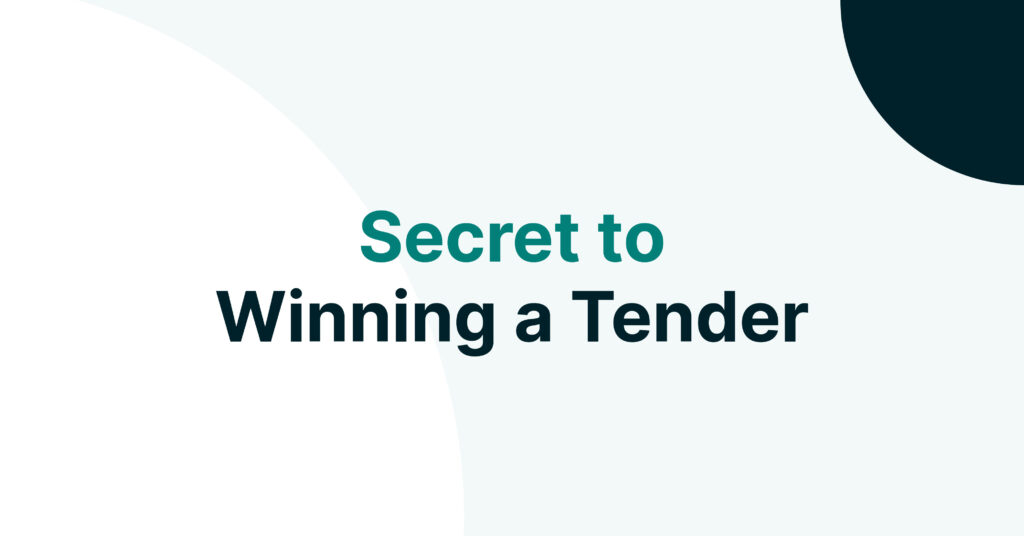Breaking Down the Tender
A how to guide of breaking down the tender
A good starting point when first breaking down the tender and wondering where to start is digesting the question. Your first point of call should be to fully understand the document and what the question is asking.
There’s a written process to follow when breaking the tender down to ensure you answer the question in full. The way buyers portray a particular question can vary. They are often asking many questions within one question. The best way to break the tender down is to pick apart the question and arrange it into sub-categories. If you don’t break down the question it makes it harder to answer. Once you have your sub-categories in order you are able to start writing your answer.
Sub-headings
For example, if a question has 10 points to it, use 10 sub-headings to cover each point of the question. By breaking the tender down into manageable chunks, it makes answering the question easier.
-
Example 1
Please explain your risk management procedures including what risks you feel are vital to overcoming as part of this contract. You should also include the monitoring and mitigation approaches you would use. Please also detail who will manage said risks and provide examples of where you have overcome similar risks.
This question asks for a lot of information. The first step to jump this hurdle is to tackle it bit by bit. First, we break this question down into more manageable chunks, allowing clear-cut focus on every aspect of the question. This makes it easier for the evaluator to mark your bid against their evaluation criteria. We always encourage you to write out sub-headings to manage this effectively. Such as:
- General Risk Management Procedures
- Contract-specific risks
- Monitoring techniques
- Mitigation approaches
- Risk Lead
- Risk Management Experience.
Under each sub-heading, you can then start to write your content.
If the question is shorter, the above guideline won’t work as you can’t break down the question. You have to work out what your response needs to include. There will be clues in the buyer’s documents.
-
Example 2
Describe how you manage risks.
This question is 5 words long. However, the required word count could be in excess of 1,000 words, depending on your offering and sector.
The management of risks may have reams of information attached to it. The important thing to do is break this down into smaller subheadings and further questioning.
Sometimes the buyer can be quite extensive in their evaluation guidance. The subheadings may be laid out for you, depending on what the buyer is looking for during the evaluation stage.
If the evaluation guidance doesn’t provide much detail, look at the specification. Make sure you fully understand what the client is looking for.
Breaking down the tender; your subheadings for the above example may be:
- Recognising Risks– detailing how you identify/assess risks?
- Monitoring Risks– what system you use to track these risks?
- Risk Responsibilities– who maintains responsibility for managing risks?
- Mitigating Risks– what to you do to mitigate said risks?
- Risk Reviews– how often do you review these to adapt to change?
- Contract Risks– what are the main risks for this particular contract?
- Compliance– what national standards/best practice do you comply with?
This is merely a small step when breaking down the tender, but a very important one. We are by no means English teachers, but we know what we are talking about!
Evaluate checklist
The evaluator will set a checklist of things they are looking for in your answer. To achieve top marks, you must include everything they are asking for in the checklist. If the evaluator has to read your response more than once, your answer is not clear and concise. They should be reading and marking your answer only once.
Consider every point of the question
Again, breaking down the tender will help you consider each point of the question. This will help you write a coherent and informative answer and will demonstrate you have fully understood the question.
Guidelines to follow
Now you’ve broken down the question, you can think about how you will structure the answer. What key details do you need to think about when writing your answer? Take a look below at topics to think about:
Budget
Does your business meet the buyer’s financial thresholds? Don’t spend hours writing a tender response if you don’t meet the criteria. You will likely be eliminated from the process in the very early stages.
Tender Plan
Assess the work that is required to compose your answer. If the word count for the question is 4,000 words, then ensure you have enough time to write this. This is the word count for a reason and 400 words simply won’t suffice. Make a plan of how you will break down the tender and how you plan to construct your answer. Planning in advance will help make answering the question easier, allowing you to write the best possible response.
Submission guide
Some buyers still like to have a hard copy of your response posted to them, along with a USB copy. You may have to email the buyer direct or submit through an electronic portal. Check to make sure you, and your colleagues fully understand not only when, but how your response should be submitted.
Description of requirements
There are several things to consider here. If you don’t read the requirements you can’t answer the question. Ask yourself:
- Have I fully understood what is required of me?
- Can my business deliver the contract if successful?
- Does my business meet the required financial thresholds?
- Does my business have the required accreditations?
- Do I understand the key objectives?
- What does the buyer require?
By highlighting these key areas, it enables you to determine if you have enough experience to deliver this.
The contract or project title
An important thing to think of when breaking down the tender is – what tender is the buyer looking for? If the buyer requires multiple works, break it down into categories.
Delivery length
How long is the contract for? It can vary from one month to three years or more. If it is only a short contract, then ask yourself, is it worth bidding? What is the likelihood of the buyer renewing or extending their contract? However, it’s also important to note that all tenders, no matter their size, help you build experience. The more experience and contract examples you have, the bigger the tenders you can apply for.
Deadline
Consider how much time you will need to write your answer. Do you have enough time to write a detailed and thorough response? If not, then it is not worth applying. You don’t want to rush and provide sloppy content just to meet the deadline. Are you working on another tender? If so, will that impact the amount of time you need to write this one?
Writing the answer
Breaking down the tender is now complete, and you can start writing your answer. There are some key points to consider when constructing your answer to ensure it’s the best it can possibly be.
Be assertive
Demonstrate your confidence in your ability when writing your answer. Show the evaluator you know what you’re talking about.
Each tender is different in terms of word count, it’s down to how the buyer wants to assess your qualitative responses. In the public sector, the evaluator is looking for the Most Economically Advantageous Tender (MEAT).
Top tips for writing assertively:
- Say “we will”. The evaluator is looking for what you can do, not what you’re trying to do.
- Give names of staff and give ownership of what they can do. Title their name with their role, it shows there are people in the team than can carry out the task.
- Remain concise by using bullet points and start each bullet point with what is going to happen. For example, Joe Bloggs will:
- Undergo
- Implement
- Action
- Mobilise
- Facilitate.
Fill the space and utilise the word count
Each question will require a word count, this is how many words are expected of you for that particular answer. If the question is asking for 1,000 words, then the evaluator is looking for a detailed response. Ensure your meet the word count required and cover all points of the questions as mentioned earlier. However, don’t just write to reach the word count. As discussed earlier in breaking down the tender. Make sure your points reflect the question.
Proofreading
You’ve broken the tender down, devised your plan and written your answer. The final step is to proofread. The most important thing before submitting your answer is to check it through thoroughly and check again. You don’t want to submit a tender that is full of bad grammar, spelling mistakes or content that doesn’t flow. Poor proofreading skills will reflect badly on your business and you could lose the bid.
Want to learn more about tendering?
We hope that answers all your questions on breaking down the tender. If you require any further support, you can find training courses here at Tender VLE. Four of our course levels are still in development but you can start your learning journey at level one now.
Our instructors offer five levels of training to accommodate all levels of learning. Whether you’re completely new to tendering or a seasoned expert, looking to improve, Tender VLE offers the resources to help. Our training is suitable for a variety of learners including businesses, freelancers or aspiring Bid Writers.
Need help with writing a bid?
Our sister company, Hudson Succeed, is a global provider of bid writing services. They have an 87% success rate and over 60 years of collective bid writing experience. Our team can support you with every step of the tendering process.
Our services include:
This 4-week programme is designed for companies that are completely new to the tendering process. One of our highly skilled Bid Writers will work alongside you, ensuring that your business is ready to tender successfully.
Our Tender Improvement programme is designed for companies that have previous experience with tendering but are yet to see results. A member of our team will review your previous tender responses and help you improve them for future tender opportunities.
Our Tender Writing service really is the whole package. Once we have the required information from you, our Bid Writing Team will take care of the rest. We’ll take charge of the entire tender for your business, from writing through to submission.
Tender Mentor
This package is suitable for companies that have already written their own tender response. A member of our team will proofread your work before the submission deadline, checking for inconsistencies, grammar or spelling errors. At your request, we will also check your responses to ensure they meet the contract’s specifications. Get in touch with a member of our expert Bid Writing Team and watch your business grow.
Upgrade to Discover Elite
Enhance your tendering experience with Discover Elite. The package ensures that you can still identify tendering opportunities even when you’re busy. Forget pre-bid admin and time-consuming breakdowns, your Account Manager will take care of this for you. Get in touch for more information.








